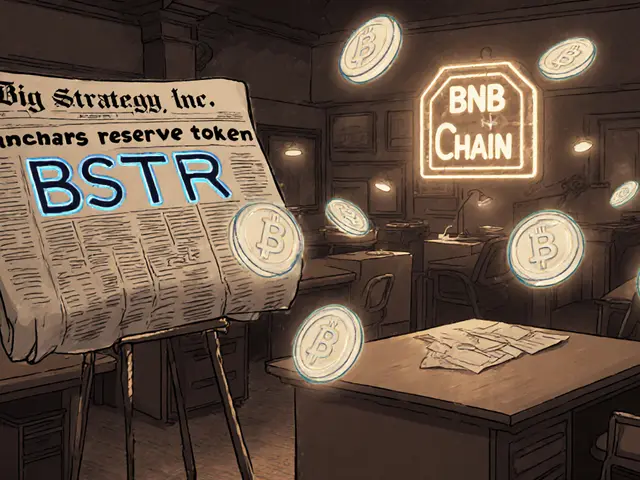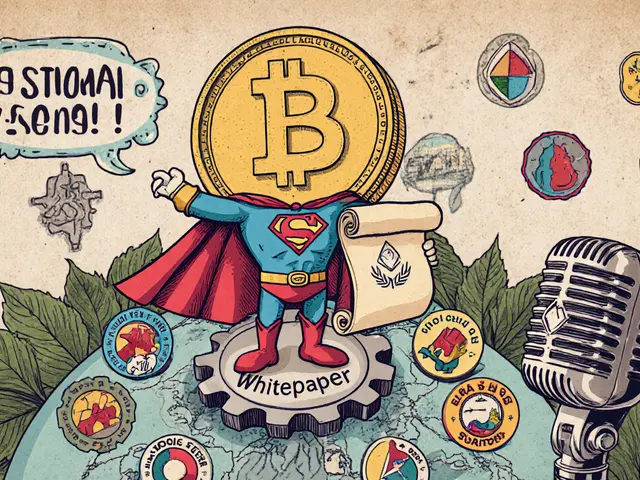
AMM Price Calculator
Enter values and click calculate to see the new price and slippage impact
Ever wondered how you can swap tokens instantly without waiting for a matchmaker? The secret lies in Automated Market Makers, the backbone of modern decentralized finance.
What is an Automated Market Maker?
Automated Market Maker is a protocol that uses smart‑contract algorithms to price and trade cryptocurrency assets without a traditional order book. AMMs debuted with the Bancor protocol in 2016, but they hit mainstream awareness when Uniswap launched its version 1 on November2,2018, eventually handling over $1.1trillion in volume by mid‑2023.
How AMMs differ from order‑book exchanges
Conventional exchanges match a buyer with a seller (peer‑to‑peer). AMMs replace that match with a peer‑to‑contract relationship. Traders swap directly against a Liquidity Pool that holds reserves of two tokens and updates prices algorithmically. This eliminates the need for a counter‑party at the moment of trade, which is crucial on blockchains where anonymity and on‑chain order management are costly.
Core mechanics: liquidity pools and pricing formulas
The heart of an AMM is its pricing curve. The most common is the Constant Product Formula (x×y=k), where x and y are token reserves and k stays constant. As you buy one asset, its reserve shrinks, pushing the price up along the curve. This guarantees availability, but large trades face steep slippage because the curve approaches infinity at the edges.
Other early designs include the constant sum (ideal for perfect 1:1 trades) and constant mean (used by Balancer, allowing multi‑token pools with custom weights). Modern variants like Uniswap v3 introduces concentrated liquidity, letting providers allocate capital to narrow price ranges, improving capital efficiency by up to 4,000×.

Major AMM protocols at a glance
| Protocol | Launch Year | Typical Fee | Special Feature |
|---|---|---|---|
| Uniswap | 2018 | 0.30% | Constant product + concentrated liquidity (v3) |
| Curve Finance | 2020 | 0.04% | Stableswap invariant for near‑peg assets |
| Balancer | 2020 | 0.10% | Multi‑token pools with custom weightings |
| PancakeSwap | 2020 | 0.20% | Binance Smart Chain integration, low fees |
| Raydium | 2021 | 0.25% | Order‑book + AMM hybrid on Solana |
Risks and rewards for liquidity providers
Liquidity providers (Liquidity Provider or LP) earn a share of the trading fees collected by a pool. Fees vary: Uniswap typically distributes 0.30% of each trade, while Curve charges only 0.04% for stablecoin pairs, resulting in higher net yields for low‑slippage assets.
However, LPs face impermanent loss - the temporary downside that occurs when the relative price of the deposited tokens changes. Studies show impermanent loss can range from 5% to 20% during volatile periods, eroding the nominal fee revenue. Many providers mitigate this by focusing on stablecoin pairs (where price drift is minimal) or by using concentrated liquidity to limit exposure to a chosen price band.
Real‑world data from Reddit’s r/DeFi community (May2023) suggests annual percentage yields of 5‑15% after accounting for impermanent loss on Uniswap v3, while Curve often delivers 2‑10% on stablecoin pools with near‑zero loss.
Getting started: a step‑by‑step guide
- Install a Web3 wallet. MetaMask leads the market with about 30million monthly active users as of Q22023.
- Fund the wallet with ETH (for gas) and the two tokens you wish to pool.
- Navigate to the AMM’s interface (e.g., Uniswap’s app). Connect your wallet.
- Choose a pool, set the amount of each token, and approve the contract to spend them.
- Review the slippage tolerance. For volatile pairs set 1‑3%; for stablecoins 0.5‑1%.
- Confirm the transaction. Pay the gas fee (average $1.50‑$50 depending on network congestion).
- Receive LP tokens representing your share. These can be staked for extra rewards on some platforms.
Remember that on Ethereum, gas spikes can dramatically affect profitability. Layer‑2 solutions like Arbitrum or Optimism now offer cheaper alternatives for the same AMM contracts.

Recent developments and the road ahead
Uniswap v4 (June52024) introduced hooks-customizable contracts that let developers embed bespoke logic into swaps, opening doors for fee rebates, on‑chain order‑book overlays, or novel price‑oracle integrations.
Beyond Ethereum, the XRP Ledger added AMM functionality via Amendment11 (December2022), allowing equal‑value deposits of any two assets. This diversification shows that AMMs are becoming blockchain‑agnostic infrastructure.
Regulators are catching up. The EU’s MiCA framework (effective Jan2024) treats AMM operators as crypto‑asset service providers, requiring licensing. In the US, the SEC’s 2023 action against Uniswap Labs underscores legal uncertainty around token listings.
Academic forecasts (BIS, 2023) predict AMM‑based trading could represent 45‑60% of all DeFi volume by 2026, while researchers at UCBerkeley envision hybrid models that blend order‑book depth with AMM liquidity to tame slippage on massive trades.
Vitalik Buterin’s 2023 interview hinted that scaling breakthroughs-like zk‑rollups and more efficient curve designs-will be essential for AMMs to serve mainstream finance without exorbitant gas costs.
Key takeaways
- AMMs replace order books with algorithmic liquidity pools, enabling instant swaps.
- The constant product formula (x×y=k) powers most pools, but newer designs (concentrated liquidity, stableswap) improve efficiency.
- Liquidity providers earn fees but must manage impermanent loss; stablecoin pools are typically safest.
- Getting started only requires a Web3 wallet, a small ETH balance for gas, and an understanding of slippage.
- Regulation, layer‑2 scaling, and hybrid order‑book models will shape the next generation of AMMs.
Frequently Asked Questions
How does an AMM set the price of a token?
Most AMMs use a mathematical invariant. The classic example is the constant product formula x×y=k, where the product of the two token reserves stays constant after each trade. The price is derived from the ratio of reserves, so buying one token pushes its price up while the other drops.
What is impermanent loss and can it be avoided?
Impermanent loss occurs when the price of the assets in a pool diverges from the price at deposit time. The loss is “impermanent” because it disappears if the price ratio returns to the original state. To reduce it, providers can stick to assets that move together (e.g., stablecoins), use pools with low volatility, or employ concentrated liquidity to limit exposure to a narrow price range.
Which AMM should I use for stablecoins?
Curve Finance’s stableswap invariant is engineered for pegged assets, offering slippage as low as 0.0001% and fees around 0.04%. For most users seeking minimal loss on USDC/USDT pairs, Curve is the go‑to platform.
Do I need to be a developer to provide liquidity?
No. Most AMM front‑ends guide you through wallet connection, token approval, and deposit steps. The technical complexity is hidden behind user‑friendly UI, though understanding gas fees and slippage settings helps you avoid costly mistakes.
Are AMMs regulated?
Regulation varies by jurisdiction. In the EU, the MiCA framework treats AMM operators as crypto‑asset service providers, requiring a license. In the US, the SEC has pursued actions against platforms it believes list unregistered securities. Always check local rules before operating large pools.





Comments (19)
Ali Korkor
Just started dipping my toes into DeFi and this broke it down so well thanks for the clear guide
madhu belavadi
why do people even care about this when the whole crypto thing is just a pyramid scheme
Dick Lane
the part about impermanent loss really hit home for me
been there lost a few bucks but still learning
Norman Woo
amms are just a distraction from the real issue
centralized exchanges are still the only thing that works
they just hide it better with blockchain buzzwords
Serena Dean
seriously love how you explained curve finance
so many people overlook it but for stablecoins its literally the best thing out there
try it out if you're new its super smooth
James Young
uniswap v3 concentrated liquidity is the only real innovation in this entire space
everyone else is just copying and charging higher fees
if you're not using v3 you're leaving money on the table
Chloe Jobson
the regulatory angle is critical
mica is a step forward but the u.s. approach is chaotic
compliance will define the next phase of amm adoption
Andrew Morgan
man i remember when uniswap v1 was the only game in town
now we got hooks and hybrid models and people still arguing about slippage
the space is wild
but honestly i just want to swap my tokens without thinking too hard
Michael Folorunsho
the fact that you think curve is the best for stablecoins shows you're still a beginner
real liquidity providers use balancer with custom weights and optimize for fee yield
curve is for retail who can't handle math
Roxanne Maxwell
thank you for including the step by step
i showed my mom and she actually understood how to connect metamask
she's now staking usdc/usdt and says she feels like a tech wizard
Jonathan Tanguay
you missed the most important point the constant product formula is mathematically flawed because it assumes infinite liquidity which is impossible in reality
and the fact that uniswap v4 allows hooks means we're heading toward a future where amms become programmable financial instruments which could lead to systemic risk if not properly audited
also why is everyone ignoring the fact that ethereum gas fees still make this inaccessible to most of the world
layer 2s are just a temporary bandaid until we get true scalability
Ayanda Ndoni
so you're telling me i can just throw my crypto into a pool and get paid
why am i still working my 9 to 5
Elliott Algarin
amms are fascinating because they turn liquidity into a public good
but they also reveal how fragile trust is in decentralized systems
when the price diverges we don't blame the market we blame the math
and yet we still keep adding liquidity
there's something deeply human in that
John Murphy
impermanent loss is real but i think its overstated
if you're holding long term and the tokens appreciate the fee income covers it
just pick pairs that move together and don't overleverage
Zach Crandall
the notion that amms are truly decentralized is a myth
the developers control the contracts
the liquidity providers are merely participants
and the regulators are already circling
this is not financial liberation it's financial colonization wrapped in code
Akinyemi Akindele Winner
amms be like a Nigerian prince with a smart contract
you think you're getting rich but you just paid for a magic token
and now your wallet is empty and the whole chain is on fire
Patrick De Leon
the eu's mica framework is the only sensible approach
the american regulatory chaos is a joke
if you want real innovation you need clear rules
not speculation and lawsuits
MANGESH NEEL
you think this is finance
this is a casino built on ethereum gas fees
the only ones winning are the devs who sold their tokens early
and the miners who got rich off your desperation
you're not building the future
you're feeding the machine
Sean Huang
amms are a fed-backed scheme to replace gold with algorithmic tokens
the constant product formula was designed by mathematicians who work for the bretton woods elite
and the hooks in v4 are just backdoors for surveillance
they want to track every swap you make
you think you're free but you're just another data point in the matrix